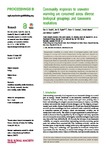Community responses to seawater warming are conserved across diverse biological groupings and taxonomic resolutions
| dc.contributor.author | Smale, DA | |
| dc.contributor.author | Taylor, JD | |
| dc.contributor.author | Coombs, SH | |
| dc.contributor.author | Moore, G | |
| dc.contributor.author | Cunliffe, Michael | |
| dc.date.accessioned | 2019-04-10T15:33:36Z | |
| dc.date.issued | 2017-09-13 | |
| dc.identifier.issn | 0962-8452 | |
| dc.identifier.issn | 1471-2954 | |
| dc.identifier.other | ARTN 20170534 | |
| dc.identifier.uri | http://hdl.handle.net/10026.1/13688 | |
| dc.description.abstract |
<jats:p> Temperature variability is a major driver of ecological pattern, with recent changes in average and extreme temperatures having significant impacts on populations, communities and ecosystems. In the marine realm, very few experiments have manipulated temperature <jats:italic>in situ</jats:italic> , and current understanding of temperature effects on community dynamics is limited. We developed new technology for precise seawater temperature control to examine warming effects on communities of bacteria, microbial eukaryotes (protists) and metazoans. Despite highly contrasting phylogenies, size spectra and diversity levels, the three community types responded similarly to seawater warming treatments of +3°C and +5°C, highlighting the critical and overarching importance of temperature in structuring communities. Temperature effects were detectable at coarse taxonomic resolutions and many taxa responded positively to warming, leading to increased abundances at the community-level. Novel field-based experimental approaches are essential to improve mechanistic understanding of how ocean warming will alter the structure and functioning of diverse marine communities. </jats:p> | |
| dc.format.extent | 20170534-20170534 | |
| dc.format.medium | ||
| dc.language | en | |
| dc.language.iso | en | |
| dc.publisher | Royal Society, The | |
| dc.subject | assemblage composition | |
| dc.subject | benthic invertebrates | |
| dc.subject | beta diversity | |
| dc.subject | community dynamics | |
| dc.subject | ocean warming | |
| dc.subject | marine biofilms | |
| dc.title | Community responses to seawater warming are conserved across diverse biological groupings and taxonomic resolutions | |
| dc.type | journal-article | |
| dc.type | Journal Article | |
| plymouth.author-url | https://www.webofscience.com/api/gateway?GWVersion=2&SrcApp=PARTNER_APP&SrcAuth=LinksAMR&KeyUT=WOS:000410610200004&DestLinkType=FullRecord&DestApp=ALL_WOS&UsrCustomerID=11bb513d99f797142bcfeffcc58ea008 | |
| plymouth.issue | 1862 | |
| plymouth.volume | 284 | |
| plymouth.publication-status | Published | |
| plymouth.journal | Proceedings of the Royal Society B: Biological Sciences | |
| dc.identifier.doi | 10.1098/rspb.2017.0534 | |
| plymouth.organisational-group | /Plymouth | |
| plymouth.organisational-group | /Plymouth/Faculty of Science and Engineering | |
| plymouth.organisational-group | /Plymouth/Faculty of Science and Engineering/School of Biological and Marine Sciences | |
| plymouth.organisational-group | /Plymouth/REF 2021 Researchers by UoA | |
| plymouth.organisational-group | /Plymouth/REF 2021 Researchers by UoA/UoA07 Earth Systems and Environmental Sciences | |
| plymouth.organisational-group | /Plymouth/Users by role | |
| plymouth.organisational-group | /Plymouth/Users by role/Academics | |
| dc.publisher.place | England | |
| dcterms.dateAccepted | 2017-07-28 | |
| dc.rights.embargodate | 2019-4-11 | |
| dc.identifier.eissn | 1471-2954 | |
| dc.rights.embargoperiod | Not known | |
| rioxxterms.versionofrecord | 10.1098/rspb.2017.0534 | |
| rioxxterms.licenseref.uri | http://www.rioxx.net/licenses/all-rights-reserved | |
| rioxxterms.licenseref.startdate | 2017-09-13 | |
| rioxxterms.type | Journal Article/Review |


